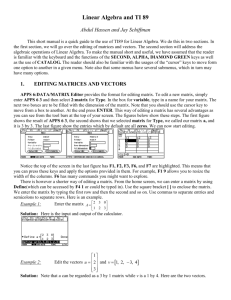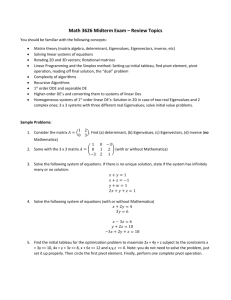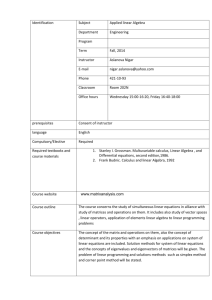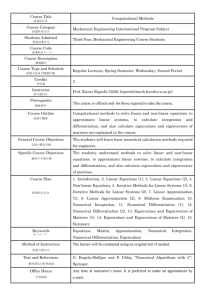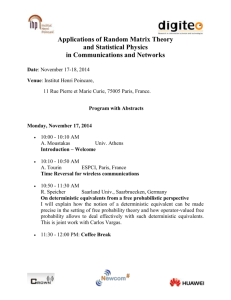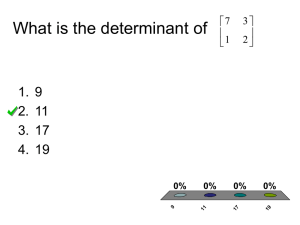On The Computation of Matrix Function having Mixed
advertisement
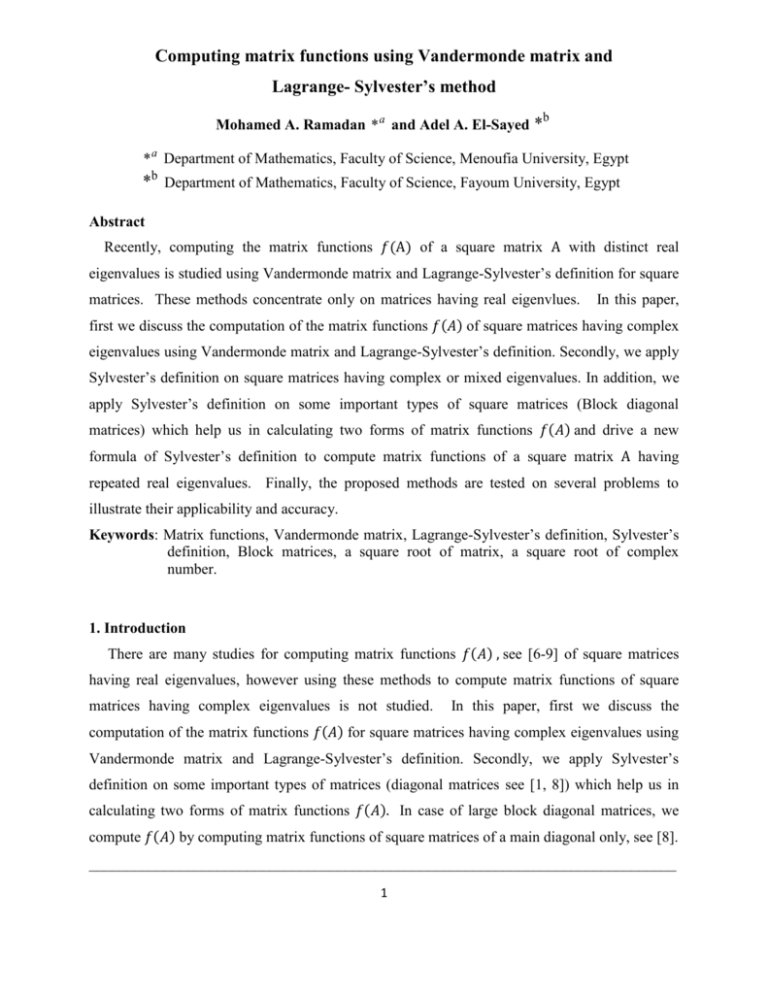
Computing matrix functions using Vandermonde matrix and
Lagrange- Sylvester’s method
Mohamed A. Ramadan * a and Adel A. El-Sayed
*b
* a Department of Mathematics, Faculty of Science, Menoufia University, Egypt
*b Department of Mathematics, Faculty of Science, Fayoum University, Egypt
Abstract
Recently, computing the matrix functions 𝑓(A) of a square matrix A with distinct real
eigenvalues is studied using Vandermonde matrix and Lagrange-Sylvester’s definition for square
matrices. These methods concentrate only on matrices having real eigenvlues.
In this paper,
first we discuss the computation of the matrix functions 𝑓(𝐴) of square matrices having complex
eigenvalues using Vandermonde matrix and Lagrange-Sylvester’s definition. Secondly, we apply
Sylvester’s definition on square matrices having complex or mixed eigenvalues. In addition, we
apply Sylvester’s definition on some important types of square matrices (Block diagonal
matrices) which help us in calculating two forms of matrix functions 𝑓(𝐴) and drive a new
formula of Sylvester’s definition to compute matrix functions of a square matrix A having
repeated real eigenvalues. Finally, the proposed methods are tested on several problems to
illustrate their applicability and accuracy.
Keywords: Matrix functions, Vandermonde matrix, Lagrange-Sylvester’s definition, Sylvester’s
definition, Block matrices, a square root of matrix, a square root of complex
number.
1. Introduction
There are many studies for computing matrix functions 𝑓(𝐴) , see [6-9] of square matrices
having real eigenvalues, however using these methods to compute matrix functions of square
matrices having complex eigenvalues is not studied.
In this paper, first we discuss the
computation of the matrix functions 𝑓(𝐴) for square matrices having complex eigenvalues using
Vandermonde matrix and Lagrange-Sylvester’s definition. Secondly, we apply Sylvester’s
definition on some important types of matrices (diagonal matrices see [1, 8]) which help us in
calculating two forms of matrix functions 𝑓(𝐴). In case of large block diagonal matrices, we
compute 𝑓(𝐴) by computing matrix functions of square matrices of a main diagonal only, see [8].
______________________________________________________________________________
1
Corresponding Author: Mohamed A. Ramadan: mramadan @eun.eg ; ramadanmohamed13@yahoo.com
Generally, we consider the problem of the computation of 𝑓(𝐴) where A is an n × n matrix and
and 𝑓 is a given analytic function in a certain domain of complex plane containing the spectrum
of A that we denote σ(A) = {λ1 , λ2 , ⋯ , λn } where the eigenvalues λ1 , λ2 , ⋯ , λn may be of the
following forms: all eigenvalues are pure complex, mixed (complex and distinct real), all are real
and distinct, all are real and repeated, some are repeated eigeanvalues.
This paper is organized as follows: In section 2, we give some important definitions for
computing matrix functions of square matrices [2-9]. In section 3, we present a generalization to
Vandermonde matrix for computing matrix functions of square matrices having pure complex
eigenvalues and illustrate the applicability of this method by an example. In section 4, an
extension of Lagrange- Sylvester’s definition for square matrices having pure complex
eigenvalues and illustrate the applicability and accuracy of this method by giving some examples.
In section 5, we extend Sylvester’s definition for square matrices having mixed eigenvalues and
also illustrate the accuracy of this method by considering some different numerical examples. In
section 6, a new formula of Sylvester’s definition to compute 𝑓(𝐴) in case of repeated real
eigenvalues of a square matrix A is deduced. The applicability and the accuracy of this technique
is illustrated by considering some numerical examples. Finally, a brief conclusion ends this
paper.
2. Preliminaries
In this section, we introduce some needed definitions for computing matrix functions of
square matrices which will be used to implement our new techniques. The following definitions
are the most generally useful ones:
(I) Vandermonde matrix for computing matrix functions [4]
If 𝑓(𝑧) is a scalar function defined on the spectrum of 𝐴 ∈ ℂ𝑛×𝑛 , Then,
𝑛−1
𝑓(𝐴) = ∑ 𝛼𝑖 𝐴𝑖 = 𝛼0 𝐼 + 𝛼1 𝐴 + 𝛼2 𝐴2 + ⋯ + 𝛼𝑛−1 𝐴𝑛−1
(2.1)
𝑖=0
where the constants 𝛼0 , 𝛼1 , 𝛼2 , ⋯ , 𝛼𝑛−1 can be computed by using Vandermonde matrix
1 𝜆0
1
𝜆1
⋮
⋮
(1 𝜆𝑛−1
𝜆20
𝜆12
⋮
𝜆2𝑛−1
⋯
⋯
⋯
⋯
𝛼0
𝜆𝑛−1
𝑓(𝜆0 )
0
𝑛−1
𝛼
𝑓(𝜆1 )
1
𝜆1
( ⋮ )=(
)
⋮
⋮
𝛼𝑛−1
𝑓(𝜆𝑛−1 )
𝜆𝑛−1
𝑛−1 )
where 𝜆0 , 𝜆1 , ⋯ , 𝜆𝑛−1 are distinct real eigenvalues of 𝐴.
2
(2.2)
(II) Lagrange-Sylvester interpolation polynomial [5]
Let 𝐴 ∈ ℂ𝑛×𝑛 be a square matrix, then we denote
𝛹(𝜆) = (𝜆 − 𝜆1 )𝑚1 (𝜆 − 𝜆2 )𝑚2 ⋯ (𝜆 − 𝜆𝑛 )𝑚𝑛
(2.3)
to the minimal polynomial of 𝐴 (where 𝜆1 , 𝜆2 , ⋯ , 𝜆𝑛 are all the distinct char-acteristic values of
the matrix 𝐴). The degree of this polynomial is 𝑚 = ∑𝑛𝑘=1 𝑚𝑘 .
If the function 𝑓(𝜆) is defined on the spectrum of the matrix 𝐴, then 𝑓(𝜎(𝐴)) = 𝑔(𝜎(𝐴)),
where 𝑔(𝜆) is an arbitrary polynomials that assumes on the spectrum of the matrix 𝐴 the same
values as does 𝑓(𝜆):
𝑓(𝐴) = 𝑔(𝐴).
Among all the polynomials with complex coefficients that assume on the spectrum of the
matrix 𝐴 the same values as 𝑓(𝜆) there is one and only one polynomial 𝑟(𝜆) that is of degree less
than 𝑚 (this polynomial is obtained from any other polynomial having the same spectral values
by taking the remainder on division by 𝛹(𝜆) of that polynomial. The polynomial 𝑟(𝜆) is
uniquely determined by the interpolation conditions:
𝑟(𝜆𝑘 ) = 𝑓(𝜆𝑘 ), 𝑟́ (𝜆𝑘 ) = 𝑓́ (𝜆𝑘 ), ⋯ , 𝑟 (𝑚𝑘 −1) (𝜆𝑘 ) = 𝑓 (𝑚𝑘 −1) (𝜆𝑘 ), 𝑘 = 1,2, ⋯ , 𝑛.
(2.4)
We consider the case in which the characteristic equation |𝐴 − 𝜆𝐼| = 0 has no multiple roots.
The roots of this equation are the characteristic values of the matrix 𝐴 which will be denoted by
𝜆1 , 𝜆2 , ⋯ , 𝜆𝑛 .
Then, 𝛹(𝜆) = |𝐴 − 𝜆𝐼| = (𝜆 − 𝜆1 )(𝜆 − 𝜆2 ) ⋯ (𝜆 − 𝜆𝑛 ) and conditions in (2.4) can be rewritten
as follows:
𝑟(𝜆𝑘 ) = 𝑓(𝜆𝑘 ),
(𝑘 = 1,2, ⋯ , 𝑛).
(2.5)
In this case, 𝑟(𝜆) is the ordinary Lagrange interpolation polynomial for the function 𝑓(𝜆) at the
points 𝜆1 , 𝜆2 , ⋯ , 𝜆𝑛 :
𝑛
𝑟(𝜆) = ∑
𝑘=1
(𝜆 − 𝜆1 ) ⋯ (𝜆 − 𝜆𝑘−1 )(𝜆 − 𝜆𝑘+1 ) ⋯ (𝜆 − 𝜆𝑛 )
𝑓(𝜆𝑘 ).
(𝜆𝑘 − 𝜆1 ) ⋯ (𝜆𝑘 − 𝜆𝑘−1 )(𝜆𝑘 − 𝜆𝑘+1 ) ⋯ (𝜆𝑘 − 𝜆𝑛 )
(2.6)
Then, 𝑓(𝐴) = 𝑟(𝐴), this means:
𝑛
𝑓(𝐴) = ∑
𝑘=1
(𝐴 − 𝜆1 𝐼) ⋯ (𝐴 − 𝜆𝑘−1 𝐼)(𝐴 − 𝜆𝑘+1 𝐼) ⋯ (𝐴 − 𝜆𝑛 𝐼)
𝑓(𝜆𝑘 ).
(𝜆𝑘 − 𝜆1 ) ⋯ (𝜆𝑘 − 𝜆𝑘−1 )(𝜆𝑘 − 𝜆𝑘+1 ) ⋯ (𝜆𝑘 − 𝜆𝑛 )
(2.7)
(III) Sylvester definition for matrix functions [2]
Sylvester, in 1883, proposed the following definition of a matrix function corresponding to the
scalar function 𝑓 (𝑧) as:
3
𝑛
𝑓(𝐴) = ∑ ∏
𝑗=0 𝑖≠𝑗
𝐴 − 𝜆𝑖 𝐼
𝑓(𝜆𝑗 )
𝜆𝑗 − 𝜆𝑖
(2.8)
where 𝐴 ∈ ℂ𝑛+1×𝑛+1 is a square matrix with distinct characteristic roots 𝜆0 , 𝜆1 , ⋯ , 𝜆𝑛 (real). This
definition is a direct extension of the Lagrange interpolation formula for a polynomial 𝑝 (𝑧) of
degree 𝑛, which is applicable only when 𝐴 has distinct real roots.
(IV) Buchheim’s definition [3]
In 1886, Buchheim generalized Sylvester’s definition to the case where the characteristic roots
are not necessarily distinct. Buchheim’s definition can be represented as:
n
sj −1
𝑓(𝐴) = ∑ ∏(A − λi I)si ∑
i=0 i≠j
k=0
dk
𝑓(z)
[
] (A − λj I)k ,
k
dz ∏h≠j(z − zh )sh
(2.9)
where sj is the multiplicity of λj as a root of the minimum polynomial of A.
(V) M. Dehghan and M. Hajarian definition for matrix functions [2]
Let 𝐴 be an (𝑛 + 1)-by- (𝑛 + 1) real matrix where its eigenvalues are not necessarily
distinct, 𝜎(𝐴) = {𝜆0 , 𝜆1 , ⋯ , 𝜆𝑛 } where 𝜆0 ≤ 𝜆1 ≤ ⋯ ≤ 𝜆𝑛 , and 𝑓: ℂ → ℂ be defined on the
spectrum of 𝐴 (𝜎(𝐴)) and 𝑓(𝑧) be a scalar analytic defined function at 𝑧 = 𝜆𝑖 for
𝑖 = 0, 1, … , 𝑛. Now they defined the matrix function 𝑓(𝐴) as follows:
𝑛
𝑖−1
𝑓(𝐴) = ∑ 𝐾[𝜆0 , 𝜆1 , … , 𝜆𝑖 ] ∏(𝐴 − 𝜆𝑗 𝐼),
𝑖=0
(2.10)
𝑗=0
in which
𝑓(𝜆1 ) − 𝑓(𝜆0 )
,
𝜆1 − 𝜆0
𝑓 (𝑘) (𝜆𝑖 )
𝐾[𝜆𝑖 , 𝜆𝑖+1 , … , 𝜆𝑖+𝑘 ] =
,
if 𝜆𝑖 = 𝜆𝑖+𝑘
𝑘!
𝑓[𝜆𝑖+1 , … , 𝜆𝑖+𝑘 ] − 𝑓[𝜆𝑖 , … , 𝜆𝑖+𝑘−1 ]
𝐾[𝜆𝑖 , 𝜆𝑖+1 , … , 𝜆𝑖+𝑘 ] =
, 𝑜𝑡ℎ𝑒𝑟𝑤𝑖𝑠𝑒.
(𝜆𝑖+𝑘 − 𝜆𝑖 )
{
𝐾[𝜆0 , 𝜆1 ] =
(2.11)
Note that: if all eigenvalues of a square matrix 𝐴 ∈ ℂ𝑛+1×𝑛+1 are equal to λ then, the matrix
function takes the form:
𝑓΄΄(𝜆)
𝑓 (𝑛) (𝜆)
2
(𝐴 − 𝜆𝐼) + ⋯ +
(𝐴 − 𝜆𝐼)𝑛 .
(2.12)
𝑓(𝐴) = 𝑓(𝜆)𝐼 + 𝑓΄(𝜆)(𝐴 − 𝜆𝐼) +
2!
𝑛!
3. Extension of Vandermonde matrix for computing matrix functions of square matrices
having pure complex eigenvalues
Our purpose in this section is to obtain approximation for computing the matrix functions
𝑓(𝐴) of square matrices having pure complex eigenvalues. We propose our method as follows:
4
General case:
Let 𝐴 ∈ ℂ𝑛×𝑛 having pure complex eigenvalues λ0 , λ1 , ⋯ , λn−1 with their complex conjugates
then the matrix function 𝑓(𝐴) takes the general form:
𝑛−1
𝑓(𝐴) = ∑ 𝛾𝑖 𝐴𝑖 = 𝛾0 𝐼 + 𝛾1 𝐴 + 𝛾2 𝐴2 + ⋯ + 𝛾𝑛−1 𝐴𝑛−1
(3.1)
𝑖=0
Now, need to find the constants 𝛾0 , 𝛾1 , 𝛾2 , ⋯ , 𝛾𝑛−1 using Vandermonde matrix.
Suppose eigenvalues of 𝐴 are 𝜆𝑗 = 𝛼𝑗 + 𝑖𝛽𝑗 with their complex conjugates
𝑛−2
𝜆𝑗̅ = 𝛼𝑗 − 𝑖𝛽𝑗 where 𝛼𝑗 , 𝛽𝑗 ∈ ℝ, 𝛽𝑗 ≠ 0 and 𝑗 = 0,1, ⋯ ,
.
2
Then, the extension of Vandermonde matrix takes the form:
1
𝜆0
1 𝜆̅0
1
𝜆1
1
𝜆1̅
⋮
⋮
1 𝜆𝑛−2
2
(
1 𝜆̅𝑛−2
2
𝜆20
(𝜆̅0 )2
𝜆12
(𝜆1̅ )2
⋮
2
𝜆𝑛−2
⋯
𝜆𝑛−1
0
⋯ (𝜆̅0 )𝑛−1
⋯
𝜆1𝑛−1
⋯
(𝜆1̅ )𝑛−1
⋯
⋮
⋯ (𝜆𝑛−2 )𝑛−1
2
2
(𝜆̅𝑛−2 )2
𝛾0
𝛾1
𝛾2
𝛾3
=
⋮
𝛾𝑛−2
(𝛾𝑛−1 )
⋯ (𝜆̅𝑛−2 )𝑛−1
2
2
)
𝑓(𝜆0 )
𝑓(𝜆̅0 )
𝑓(𝜆1 )
𝑓(𝜆1̅ )
⋮
𝑓(𝜆𝑛−2 )
(3.2)
2
(
𝑓(𝜆̅𝑛−2 )
2
)
Solving the system of linear equations in (3.2) then, the constants 𝛾0 , 𝛾1 , 𝛾2 , ⋯ , 𝛾𝑛−1 can be
found and now, substitute in (3.1) to get 𝑓(𝐴) .
3.1 Numerical example
1 2
) ∈ ℂ2×2 , 𝑓(𝑧) = √𝑧 then compute 𝑓(𝐴)
−2 1
It is not difficult to obtain the eigenvalues of 𝐴 which are {1 + 2𝑖, 1 − 2𝑖}
Let 𝐴 = (
then , 𝑓(𝐴) = 𝛾0 𝐼 + 𝛾1 𝐴
(3.3)
To find the constants 𝛾0 and 𝛾1 using extension of Vandermonde matrix as in Eq. (3.2) then,
1
1
(
𝑓(1 + 2𝑖)
1 + 2𝑖 𝛾0
) (𝛾 ) = (
)
𝑓(1 − 2𝑖)
1 − 2𝑖
1
Since 𝑓(1 + 2𝑖) = √1 + 2𝑖
(3.4)
then, using polar coordinate we can get
𝑓(1 + 2𝑖) ≅ 1.27202 + 0.78615𝑖,
𝑓(1 − 2𝑖) ≅ 1.27202 − 0.78615𝑖 ,
then substitute in (3.4) get the matrix equation as the form:
1 1 + 2𝑖 𝛾0
1.272 + 0.78615𝑖
(
) (𝛾 ) = (
)
1 1 − 2𝑖
1
1.272 − 0.78615𝑖
(3.5)
Now, solving system of equations (3.5) we get:
𝛾0 = 0.878945 and 𝛾1 = 0.393075
(3.6)
5
Then, substitute from Eq. (3.6) in Eq. (3.3) we have:
1
0
𝑓(𝐴) = 0.878945 (
0
1 2
1.27202
) + 0.393075 (
)≅(
1
−2 1
−0.78615
0.78615
)
1.27202
Note: since 𝑓(𝐴) = √𝐴 then (𝑓(𝐴))2 = (√𝐴)2 = √𝐴. √𝐴 = 𝐴
In this example we test the accuracy of the proposed method:
1.27202
−0.78615
√𝐴. √𝐴 = (
0.78615
1.27202
).(
1.27202
−0.78615
0.78615
1 2
)≅(
)=𝐴
−2 1
1.27202
This shows that our technique maintains high accuracy.
4. The Lagrange-Sylvester interpolation polynomial for computing matrix functions of
square matrices having pure complex eigenvalues
Since for computing matrix functions of square matrices having distinct real eigenvalues is
previously investigated (see [5]) and definition (II). Therefore, we need to investigate the
computation of matrix functions of square matrices having pure complex eigenvalues. The
following method is proposed through after several steps:
Method I: General method for computing matrix functions of square matrices having pure
complex eigenvalues
Let 𝐴 ∈ ℂ𝑛×𝑛 be a square matrix having pure complex eigenvalues, that is the spectrum
of 𝐴(𝜎(𝐴)) is of the form 𝜎(𝐴) = { 𝜆1 , 𝜆1̅ , 𝜆2 , 𝜆̅2 , ⋯ , 𝜆𝑛 , 𝜆̅𝑛 } and 𝑓(𝑧) be a scalar analytic
2
2
function defined on the spectrum of 𝐴 . Then,
𝑛
2
𝑛
2
(𝐴 − 𝜆̅𝑘 𝐼)(𝐴 − 𝜆𝑗 𝐼)(𝐴 − 𝜆𝑗̅ 𝐼)
𝑓(𝐴) = ∑ ∏
𝑓(𝜆𝑘 )
(𝜆𝑘 − 𝜆̅𝑘 )(𝜆𝑘 − 𝜆𝑗 )(𝜆𝑘 − 𝜆𝑗̅ )
𝑘=1,3 𝑗=1,
𝑗≠𝑘
𝑛
2
𝑛
2
+ ∑ ∏
𝑘=1,3 𝑗=1,
𝑗≠𝑘
𝑛
𝑛
2
2
+ ∑ ∏
𝑘=2,4 𝑗=1,
𝑗≠𝑘
𝑛
𝑛
2
2
+ ∑ ∏
𝑘=2,4 𝑗=1,
𝑗≠𝑘
(𝐴 − 𝜆𝑘 𝐼)(𝐴 − 𝜆𝑗 𝐼)(𝐴 − 𝜆𝑗̅ 𝐼)
𝑓(𝜆̅𝑘 )
(𝜆̅𝑘 − 𝜆̅𝑘 )(𝜆̅𝑘 − 𝜆𝑗 )(𝜆̅𝑘 − 𝜆𝑗̅ )
(𝐴 − 𝜆𝑗 𝐼)(𝐴 − 𝜆𝑗̅ 𝐼)(𝐴 − 𝜆̅𝑘 𝐼)
𝑓(𝜆𝑘 )
(𝜆𝑘 − 𝜆𝑗 )(𝜆𝑘 − 𝜆𝑗̅ )(𝜆𝑘 − 𝜆̅𝑘 )
(𝐴 − 𝜆𝑗 𝐼)(𝐴 − 𝜆𝑗̅ 𝐼)(𝐴 − 𝜆𝑘 𝐼)
𝑓(𝜆̅𝑘 )
(𝜆̅𝑘 − 𝜆𝑗 )(𝜆̅𝑘 − 𝜆𝑗̅ )(𝜆̅𝑘 − 𝜆𝑘 )
6
(4.1)
where:
𝑛
𝜆𝑘 = 𝛼𝑘 + 𝑖𝛽𝑘 , 𝛼𝑘 , 𝛽𝑘 ∈ ℝ, 𝛽𝑘 ≠ 0, 𝑘 = 1,2,3, ⋯ , 2,
𝑛
𝑛 ∈ 2𝑧Ƶ+ , 𝑛 ≥ 2, 𝑗 = 1,2,3, ⋯ , 2 , 𝑘 ≠ 𝑗
and 𝜆̅𝑘 is a complex conjugate of 𝜆𝑘 .
4.1 Numerical example
1
2
Let 𝐴 = (
0
0
−2
1
0
0
0 0
0 0
) ∈ ℂ4×4 , 𝑓(𝑧) = √𝑧 then compute 𝑓(𝐴)
3 −4
4 3
Eigenvalues [𝐴] = {3 + 4𝑖, 3 − 4𝑖, 1 + 2𝑖, 1 − 2𝑖}
1
0
Suppose 𝜆1 = 3 + 4𝑖; 𝜆1̅ = 3 − 4𝑖; 𝜆2 = 1 + 2𝑖; 𝜆̅2 = 1 − 2𝑖; 𝐼 = (
0
0
0
1
0
0
0
0
1
0
0
0
)
0
1
𝑓[𝑧− ]: = 𝑁[√𝑧]
Now, using our suggested method I we have:
𝑓(𝐴) =
𝑓[𝜆1 ]
(𝜆1 − 𝜆1̅ )(𝜆1 − 𝜆2 )(𝜆1 − 𝜆̅2 )
(𝐴 − 𝜆1̅ I). (𝐴 − 𝜆2 I). (𝐴 − 𝜆̅2 I)
+
𝑓[𝜆1̅ ]
(𝐴 − 𝜆1 I). (𝐴 − 𝜆2 I). (𝐴 − 𝜆̅2 I)
(𝜆1̅ − 𝜆1 )(𝜆1̅ − 𝜆2 )(𝜆1̅ − 𝜆̅2 )
+
𝑓[𝜆2 ]
(𝐴 − 𝜆1 I). (𝐴 − 𝜆1̅ I). (𝐴 − 𝜆̅2 I)
(𝜆2 − 𝜆1 )(𝜆2 − 𝜆1̅ )(𝜆2 − 𝜆̅2 )
+
𝑓[𝜆̅2 ]
(𝐴 − 𝜆1 I). (𝐴 − 𝜆1̅ I). (𝐴 − 𝜆2 I)
(𝜆̅2 − 𝜆1 )(𝜆̅2 − 𝜆1̅ )(𝜆̅2 − 𝜆2 )
= {{1.27202 + 0. 𝑖, −0.786151 + 0. 𝑖, 0 + 0. 𝑖, 0 + 0. 𝑖},
{0.786151 + 0. 𝑖, 1.27202 + 0. 𝑖, 0. 𝑖, 0 + 0. 𝑖, 0 + 0. 𝑖},
{0. 𝑖, 0 + 0. 𝑖, 0 + 0. 𝑖, 2 + 0. 𝑖, −1 + 0. 𝑖}, {0 + 0. 𝑖, 0 + 0. 𝑖, 1 + 0. 𝑖, 2 + 0. 𝑖}}
MatrixForm [%]
1.27202 + 0. 𝑖
0.786151 + 0. 𝑖
𝑓(𝐴) = (
0 + 0. 𝑖
0 + 0. 𝑖
−0.786151 + 0. 𝑖
1.27202 + 0. 𝑖
0 + 0. 𝑖
0 + 0. 𝑖
0 + 0. 𝑖
0 + 0. 𝑖
2 + 0. 𝑖
1 + 0. 𝑖
7
0 + 0. 𝑖
0 + 0. 𝑖
)
−1 + 0. 𝑖
2 + 0. 𝑖
It is known that any 𝐾 such that K 2 = A, then K is the a square root of matrix A. Now we obtain:
1
2
2
(𝑓(A)) = (√A) = √A. √A ≅ (
0
0
2
−2
1
0
0
0 0
0 0
)=𝐴
3 −4
4 3
This shows that our method gives a very high accuracy.
5. Extension of Sylvester’s definition for computing matrix functions of square matrices
having mixed (distinct real and pure complex) eigenvalues
Our purpose in this section is to obtain approximation for computing the matrix function
𝑓(𝐴) for some types of square matrices having mixed eigenvalues using extension Sylvester’s
definition. For Sylvester’s definition (III) as in Eq. (2.8), we extend it in the following two stages
depending on the type of the eigenvalues of a square matrix A:
Stage 5.1
Let A ∈ ℂ3×3 be a square matrix having mixed eigenvalues (one real and the other is complex
with its complex conjugate). Now, Assume λ1 is real eigenvalue and λ2 is the complex
eigenvalue with its complex conjugate λ̅2 then,
𝑓(𝐴) =
(A − λ2 I)(A − λ̅2 I)
(A − λ1 I)(A − λ̅2 I)
(A − λ1 I)(A − λ2 I)
𝑓(𝜆1 ) +
𝑓(𝜆2 ) +
𝑓(𝜆̅2 )
(λ1 − λ2 )(λ1 − λ̅2 )
(λ2 − λ1 )(λ2 − λ̅2 )
(λ̅2 − λ1 )(λ̅2 − λ2 )
(5.1)
Stage 5.2
Let A ∈ ℂ4×4 be a square matrix having mixed eigenvalues (two real and one complex
eigenvalue with its complex conjugate). Then, suppose A has two real eigenvalues λ1 , λ2 and one
complex eigenvalue λ3 with its complex conjugate λ̅3 . Then,
𝑓(A) =
(A − λ2 I)(A − λ3 I)(A − λ̅3 I)
(A − λ1 I)(A − λ3 I)(A − λ̅3 I)
𝑓(λ1 ) +
𝑓(λ2 )
(λ1 − λ2 )(λ1 − λ3 )(λ1 − λ̅3 )
(λ2 − λ1 )(λ2 − λ3 )(λ2 − λ̅3 )
+
(A − λ1 I)(A − λ2 I)(A − λ3 I)
(A − λ1 I)(A − λ2 I)(A − λ̅3 I)
𝑓(λ3 ) +
𝑓(λ̅3 )
(λ3 − λ1 )(λ3 − λ2 )(λ3 − λ̅3 )
(λ̅3 − λ1 )(λ̅3 − λ2 )(λ̅3 − λ3 )
(5.2)
Remark: A generalization of this extension of Sylvester’s definition can be easily derived for any
size of block diagonal matrices; also this derivation is applicable for computing matrix functions
of this type of square matrices. Also, we can compute matrix functions for any 𝐴 ∈ ℂ𝑛×𝑛 having
mixed eigenvalues by follow the same steps as in these stages. This generalization will be
illustrated in the following examples.
8
5.1 Numerical examples
In this section we propose several problems to support our investigated techniques.
Example 5.1
1 −3 11
Let 𝐴 = (2 −6 16) ∈ ℂ3×3 , 𝑓(𝑧) = √𝑧 then compute 𝑓(𝐴)
1 −3 7
It is not difficult to obtain σ(𝐴) = {1 + 𝑖, 1 − 𝑖, 0}. Suppose 𝜆1 = 1 + 𝑖; 𝜆1̅ = 1 − 𝑖; 𝜆2 = 0;
1
𝐼 = (0
0
0 0
1 0) ,
0 1
𝑓[𝑧− ]: = 𝑁[√𝑧]
Now, using stage 5.1 as in Eq. (5.1) we have:
𝑓(𝐴) =
𝑓[𝜆1̅ ]
𝑓[𝜆1 ]
(𝐴 − 𝜆1 I). (𝐴 − 𝜆2 I)
(𝐴 − 𝜆1̅ I). (𝐴 − 𝜆2 I) +
(𝜆1 − 𝜆1̅ )(𝜆1 − 𝜆2 )
(𝜆1̅ − 𝜆1 )(𝜆1̅ − 𝜆2 )
+
𝑓[𝜆2 ]
(𝐴 − 𝜆1 I). (𝐴 − 𝜆1̅ I)
(𝜆2 − 𝜆1 )(𝜆2 − 𝜆1̅ )
−0.832099 + 0. 𝑖
= ( 0.266585 + 0. 𝑖
0.45509 + 0. 𝑖
2.4963 + 0. 𝑖
−0.799756 + 0. 𝑖
−1.36527 + 0. 𝑖
−0.78636 + 0. 𝑖
5.35066 + 0. 𝑖 )
3.82922 + 0. 𝑖
Note: if the results are tested then obtain approximately the exact value of 𝐴.
Example 5.2
1
2
Let 𝐴 = (
0
0
−2
1
−2
1
3 −4
4 3
) ∈ ℂ4×4 , 𝑓(𝑧) = √𝑧 then compute 𝑓(𝐴)
3 −4
4 3
1
It is not difficult to obtain σ(𝐴) = {2 (7 + 𝑖√111),
1
2
(7 − 𝑖√111), 1, 0}. Now, suppose 𝜆1 =
1
0
(7 + 𝑖√111); 𝜆1̅ = 2 (7 − 𝑖√111); 𝜆2 = 1; 𝜆3 = 0; 𝐼 = (
2
0
0
1
1
0
1
0
0
0
0
1
0
Now, using stage 5.2 as in Eq. (5.2) we have:
𝑓(𝐴) =
𝑓[𝜆1 ]
(𝜆1 − 𝜆1̅ )(𝜆1 − 𝜆2 )(𝜆1 − 𝜆3 )
(𝐴 − 𝜆1̅ I)(𝐴 − 𝜆2 I)(𝐴 − 𝜆3 I)
+
𝑓[𝜆1̅ ]
(𝐴 − 𝜆1 I)(𝐴 − 𝜆2 I)(𝐴 − 𝜆3 I)
(𝜆1̅ − 𝜆1 )(𝜆1̅ − 𝜆2 )(𝜆1̅ − 𝜆3 )
+
𝑓[𝜆2 ]
(𝐴 − 𝜆1 I)(𝐴 − 𝜆1̅ I)(𝐴 − 𝜆3 I)
(𝜆2 − 𝜆1 )(𝜆2 − 𝜆1̅ )(𝜆2 − 𝜆3 )
9
0
0
), 𝑓[𝑧− ]: = 𝑁[√𝑧]
0
1
+
𝑓[𝜆3 ]
(𝐴 − 𝜆1 I)(𝐴 − 𝜆1̅ I)(𝐴 − 𝜆2 I)
(𝜆3 − 𝜆1 )(𝜆3 − 𝜆1̅ )(𝜆3 − 𝜆2 )
1.07675 + 0. 𝑖
1.46716 + 0. 𝑖
=(
0.142679 + 0. 𝑖
−0.400979 + 0. 𝑖
−0.451189 + 0. 𝑖
0.760639 + 0. 𝑖
−0.522528 + 0. 𝑖
0.61796 + 0. 𝑖
1.30998 + 0. 𝑖
−0.0368473 + 0. 𝑖
1.96089 + 0. 𝑖
1.26498 + 0. 𝑖
−0.787252 + 0. 𝑖
1.72203 + 0. 𝑖
)
−0.831039 + 0. 𝑖
1.63445 + 0. 𝑖
It is known that any K such that K 2 = A, then K is the square root of matrix A. Now we obtain:
1
2
(𝑓(A)) = (√A) = √A. √A = (
3.08428 × 10−16
−1.088 × 10−16
2
2
−2
1
−2
1
3 −4
4 3
)≅𝐴
3 −4
4 3
Note: By comparing the obtained results with the exact value of 𝐴 an error 3.08428 × 10−16 is
obtained. This illustrates the applicability of our method and show that this method gives high
accuracy for approximating matrix functions 𝑓(𝐴) for square matrices having mixed eigenvalues.
Example 5.3
1 −2 0 1
4 1 2 8
Let 𝐴 = 2 3 2 7
0 0 0 3
(0 0 0 4
10
6
5 ∈ ℂ5×5, 𝑓(𝑧) = √𝑧 then compute 𝑓(𝐴)
−4
3)
1
1
2
2
It is not difficult to obtain σ(𝐴)={3 + 4𝑖; 3 − 4𝑖; (3 + 𝑖√7); (3 − 𝑖√7); 1}
1
1
Suppose: 𝜆1 = 3 + 4𝑖; 𝜆1̅ = 3 − 4𝑖; 𝜆2 = 2 (3 + 𝑖√7); 𝜆̅2 = 2 (3 − 𝑖√7); 𝜆3 = 1
1
0
𝐼= 0
0
(0
0
0
𝑓[𝑧− ]: = 𝑁[√𝑧]
0 ,
0
1)
Now, using generalization of stage 5.2 then, we have:
𝑓(𝐴) =
0
1
0
0
0
0
0
1
0
0
0
0
0
1
0
𝑓[𝜆1 ](𝐴 − 𝜆1̅ I). (𝐴 − 𝜆2 I). (𝐴 − 𝜆̅2 I). (𝐴 − 𝜆3 I)
(𝜆1 − 𝜆1̅ )(𝜆1 − 𝜆2 )(𝜆1 − 𝜆̅2 )(𝜆1 − 𝜆3 )
+
𝑓[𝜆1̅ ](𝐴 − 𝜆1 I). (𝐴 − 𝜆2 I). (𝐴 − 𝜆̅2 I). (𝐴 − 𝜆3 I)
(𝜆1̅ − 𝜆1 )(𝜆̅1 − 𝜆2 )(𝜆1̅ − 𝜆̅2 )(𝜆1̅ − 𝜆3 )
+
𝑓[𝜆2 ](𝐴 − 𝜆1 I)(𝐴 − 𝜆1̅ I). (𝐴 − 𝜆̅2 I). (𝐴 − 𝜆3 I)
(𝜆2 − 𝜆1 )(𝜆2 − 𝜆1̅ )(𝜆2 − 𝜆̅2 )(𝜆2 − 𝜆3 )
10
+
𝑓[𝜆̅2 ](𝐴 − 𝜆1 I). (𝐴 − 𝜆1̅ I). (𝐴 − 𝜆2 I). (𝐴 − 𝜆3 I)
(𝜆̅2 − 𝜆1 )(𝜆̅2 − 𝜆1̅ )(𝜆̅2 − 𝜆2 )(𝜆̅2 − 𝜆3 )
+
𝑓[𝜆3 ](𝐴 − 𝜆1 I). (𝐴 − 𝜆1̅ I). (𝐴 − 𝜆2 I). (𝐴 − 𝜆̅2 I)
(𝜆3 − 𝜆1 )(𝜆3 − 𝜆1̅ )(𝜆3 − 𝜆2 )(𝜆3 − 𝜆̅2 )
= {{1.53557, −0.889822 + 5.55112 × 10−17 𝑖, 0.267787, −0.0603337 − 8.88178 × 10−16 𝑖, 2.89255}
−16
, {1.51186, 1.13389 − 1.11022 × 10
𝑖, 0.755929,2.12949 − 8.88178 × 10−16 𝑖,
0.808917 − 4.44089 × 10−16 𝑖}, {−0.0474316,1.40168, 0.976284, 0.805245, 1.61564},
{0, 0, 0, 2 + 2.22045 × 10−16 𝑖, −1}, {0, 0, 0, 1, 2.22045 × 10−16 𝑖}}
2
2
Since 𝑓(A) = √A this implies (𝑓(A)) = (√A) = √A. √A = A then, we test the result. Since,
√A. √A = {{1 + 8.3925 × 10−17 𝑖, −2 + 2.46975 × 10−16 𝑖, 4.95941 × 10−16 + 4.19625 × 10−17 𝑖,
1 − 2.24509 × 10−15 𝑖, 10 + 1.97052 × 10−15 𝑖}, {4 − 1.6785 × 10−16 𝑖, 1 −
1.6785 ×
10−16 𝑖, 2 − 8.3925 × 10−17 𝑖, 8 − 4.33392 × 10−15 𝑖, 6 − 4.13742 × 10−16 𝑖},
{2,3 − 1.58251 × 10−16 𝑖, 2,7 − 1.02401 × 10−15 𝑖, 5 − 2.63727 × 10−16 𝑖},
{0, 0, 0,3 + 8.88178 × 10−16 𝑖, −4 − 4.44089 × 10−16 𝑖},
{0, 0, 0, 4 + 4.44089 × 10−16 𝑖, 3 + 8.88178 × 10−16 𝑖}}
Remarks:
1- By comparing of the obtained results with the exact value of 𝐴 in this example the absolute
error of the real part is approximately 4.95941 × 10−16 and the absolute error of the
imaginary part is about 4.19625 × 10−17 . This illustrates the applicability of our method (the
method in stage 2) as in Eq. (2.4.2) and show that this method gives high accuracy for
approximating matrix functions 𝑓(𝐴) of square matrices having mixed eigenvalues.
2- All computations in this section are done using MATHEMATICA 6 Program.
6. Extension of Sylvester’s definition for computing matrix functions of square matrices
having repeated real eigenvalues
If we use definition (II) directly for computing matrix functions of square matrices having
real repeated eigenvalues we face a problem in computation because the denominator is equal to
zero, although if we use definition (III) as in Eq. (2.9) can compute 𝑓(𝐴) but this methods need to
high derivatives in case of repeated real eigenvalues many times as in Eq. (2.9). So we try to get
a new technique to ignore zeroes of denominator and high derivatives in the same time. In this
11
section, we use definition (II) and present a new technique for computing matrix functions of
square matrices having special forms with real repeated eigenvalues. This technique is proposed
after several steps and several cases. Now, we have:
Case 6.1: Let A ∈ ℂ2×2 be a square matrix having one real eigenvalue repeated twice. We study
it in the following two forms:
Case 6.1a: Let A be a diagonal matrix having one real eigenvalue repeated twice.
Assume: A = (
a 0
) ∈ ℂ2×2 and 𝑓(z) is analytic function defined on the domain of the
0 a
spectrum of A then,
𝑓(a)
0
𝑓(A) = (
)
0
𝑓(a)
Case 6.1b: Let A be an upper triangular matrix having one real eigenvalue repeated twice.
a b
) ∈ ℂ2×2 then, consider eigenvalues having the form λ0 = a, λ1 ≅ a +
0 a
Assume: A = (
θ then, we compute 𝑓(A) by using extension of Sylvester’s definition as:
𝑓(A) =
(A − λ1 I)
(A − λ0 I)
𝑓(λ0 ) +
𝑓(λ1 )
(λ0 − λ1 )
(λ1 − λ0 )
1 0
a b
a
(
) − (a + θ) (
)
(
0 1 ) 𝑓(λ ) + ( 0
=( 0 a
0
a − (a + θ)
1 0
b
) − (a) (
)
0 1 ) 𝑓(λ )
a
1
(a + θ) − a
To show how to determine the value of the parameter θ according to the required accuracy,
consider the case of computing the principle square root of a square matrix 𝐴. Thus, we have:
𝑓(A) = (√a
0
−b√a b√(a + θ)
+
)
θ
θ
√a
(6.1)
Our problem now is how we find the value of the parameter θ.
Since 𝑓(A) = √A this implies to (𝑓(A))2 = (√A)2 = √A. √A = A
−b√a b√(a + θ)
))
√A. √A = ( a 2√a( θ +
θ
0
a
Hence,
−b√a
A = (a 2√a( θ +
0
a
and we can obtain:
b√(a+θ)
θ
)) = A = (a b). This implies to 2b√a [√(a+θ)−√a] = b,
θ
0 a
12
(6.2)
√a(a + θ) − a 1
=
.
θ
2
(6.3)
Case 6.2: Let A ∈ ℂ3×3 be a square matrix having one real eigenvalue repeated three times. We
study it in two forms:
Case 6.2a: Let A be a square diagonal matrix having one real eigenvalue repeated three times.
a
Suppose: A = (0
0
of A then,
0 0
a 0) and 𝑓(z) is analytic function defined on the domain of the spectrum
0 a
𝑓(a)
0
0
𝑓(a)
0 )
𝑓(A) = ( 0
0
0
𝑓(a)
Case 6.2b: Let A be an upper triangular square matrix and having one real eigenvalue repeated
three times
a
Suppose: A = (0
0
b 0
a 0) , 𝑓(z) = √z then, we compute 𝑓(A) by using extension of Sylvester’s
0 a
definition.
It is clear that the eigenvalues of A are real and equal to {a, a, a}, which cause a problem for us in
computing matrix function by using Sylvester’s definition directly. To solve this problem we
suppose the following assumptions: λ0 = a, λ1 ≅ a + θ and λ2 ≅ a + 2θ.
For some small
real number θ this will be determined later according the required accuracy of 𝑓(A). Then, we
have:
𝑓(A) =
(A − λ1 I)(A − λ2 I)
(A − λ0 I)(A − λ2 I)
(A − λ0 I)(A − λ1 I)
𝑓(λ0 ) +
𝑓(λ1 ) +
𝑓(λ2 )
(λ0 − λ1 )(λ0 − λ2 )
(λ1 − λ0 )(λ1 − λ2 )
(λ2 − λ0 )(λ2 − λ1 )
−1 −1 −θ
.
(0
θ 2θ
0
1 −1 0 b
+ .
(0 0
θ θ
0 0
1 1 0 b
+ . (0 0
2θ θ
0 0
=
√a
=
0
(0
b
0
−2θ
b
0
)
.
(
−θ 0
0
−2θ
0 ) √a
0 −θ
0
0
−2θ
0
−2θ
b
0
0) . ( 0
−2θ
0 ) √a + θ
0
0
0
−2θ
0
−θ b
0
0) . ( 0 −θ 0 ) √a + 2θ
0
0
0 −θ
−3b√a 2b√a + θ b√a + 2θ
+
−
2θ
θ
2θ
√a
0
0
0
√ a)
13
(6.4)
Now, our aim is to find the value of real number θ. Since, 𝑓(A) = √A this implies that
(𝑓(A))2 = (√A)2 = √A. √A = A . Hence, we can obtain:
−3b√a 2b√a + θ b√a + 2θ
2 √a (
+
−
)=b
2θ
θ
2θ
This implies
4√a + θ − √a + 2θ − 3√a
1
=
θ
√a
(6.5)
Thus, we can obtain value of real number θ from the following Table:
Suppose the repeated eigenvalues are real number and all equal to the number four (a = 4) then,
Table 6.1 Determination the value of the parameter θ
θ
(4√4 + θ − √4 + 2θ − 3√4)⁄θ
1
0.494782167
0.8
0.496411258
0.6
0.497822309
0.4
0.498951388
0.1
0.499925393
0.001
0.5
exact
1× 10−5 0.5
exact
From Table 6.1 we get on θ ∈ (0 , 1] and gives us a high approximation when θ tends to zero.
Note: if the repeated eigenvalue of a square matrix A are any positive real numbers we will get
on θ ∈ ]0,1] and we have a high approximation and accuracy when θ tends to zero.
Case 6.3: Let A ∈ ℂ3×3 be a square matrix having only two real repeated eigenvalues.
a
Suppose: A = (0
0
0 0
a 0) , 𝑓(z) = √z then, we compute 𝑓(A) by using extension of Sylvester’s
0 b
definition.
Since eigenvalues of A are {a, a, b} so we can’t apply Sylvester’s definition directly, but we can
solve this problem by using the following assumption: λ0 = a, λ1 ≅ a + θ and λ2 = b.
14
For some small real number θ will be determined later according the required approximation and
accuracy of 𝑓(A). Then as previous cases introduced in this section we can obtain 𝑓(A) and θ ∈
]0,1] .
Now, from cases 1, 2 and 3 a general method for computing matrix functions of square
matrices having not necessarily distinct real eigenvalues can be introduced using an extension of
Sylvester's definition as in the next method:
Method II: General method for computing matrix functions of square matrices having real
repeated eigenvalues
Let 𝐴 ∈ ℂ𝑛×𝑛 be a square matrix having real repeated eigenvalues as in spectrum of 𝐴(𝜎(𝐴))
of the form 𝜎(𝐴) = { 𝜆1 , 𝜆1 , 𝜆1 , ⋯ , 𝜆1 , 𝜆1 } where 𝜆1 is repeated 𝑛 times and 𝑓(𝑧) be a scalar
analytic function defined on the spectrum of 𝐴 . Then,
𝑛
𝑓(𝐴) = ∑ ∏
𝑗=1 𝑖≠𝑗
𝐴 − 𝜆𝑖 𝐼
𝑓(𝜆𝑗 )
𝜆𝑗 − 𝜆𝑖
(6.6)
where eigenvalues takes the form:
𝜆1 , 𝜆2 = 𝜆1 + 𝜃, 𝜆3 = 𝜆1 + 2𝜃, 𝜆4 = 𝜆1 + 3𝜃, ⋯ , 𝜆𝑛 = 𝜆1 + (𝑛 − 1)𝜃, 𝜃 ∈]0,1]
(6.7)
and we get high accuracy for matrix functions 𝑓(𝐴) when 𝜃 tends to zero. Also this illustrates
the applicability of our method.
Note: If 𝑓(z) is any another scalar analytic function defined on the complex plane of the
spectrum of A (σ(A)), we can compute matrix functions of square matrices having real repeated
eigenvalues by using extension of Sylvester’s definition as we introduced it in section 6. Also,
the proposed method II is practical in case of large order block diagonal matrices.
6.1 Numerical examples
In this subsection, we present several numerical examples to support our theoretical results
and illustrate the applicability and accuracy of the presented method. We compute 𝑓(A) in all
possible cases of repeated real eigenvalues for a square matrix A which introduced in this section
Example 6.1
Suppose A = (
4 0
) , 𝑓(z) = √z then compute 𝑓(A).
0 4
It’s clear that eigenvalue of a square matrix A is one real and repeated twice then, by using case
6.1a as in Eq. (6.1) then, we have:
15
2 0
) = √A
0 2
𝑓(A) = (
Example 6.2
4 2
) , 𝑓(z) = √z then compute 𝑓(A).
0 4
Let A = (
It is clear that A is of an upper triangular form having one real eigenvalue repeated twice. Then,
using case 6.1b as in Eq. (6.1) and Eq. (6.3) then, we have:
𝑓(A) = √A = (2
0
2 √4 + θ − 4
)
θ
2
where θ ∈ ]0, 1] and we have a high accuracy as θ tends to zero.
Since, we know 𝑓(A) = √A implies that (𝑓(A))2 = (√A)2 = √A. √A = A . This implies
to
2√4+θ−4
θ
2
= 0.5. this implies 𝑓(A) = √A = (
0
0.5
)
2
Now, the following Table supports our theoretical method.
Table 6.2: Determination the value of the parameter θ
θ
(2√4 + θ − 4)⁄θ
1
0.472135
0.8
0.477225
0.6
0.482536
0.4
0.488088
0.2
0.4939015
0.1
0.4969134
0.001
0.499968
1× 10−4 0.499996
1× 10−5 0.5
exact
Table 6.2 illustrates numerically our theoretical findings. Also if we compute (𝑓(A))2 , we get
approximately the exact value of A.
16
Example 6.3
Let A = (
4
0
2
) , 𝑓(z) = ez then compute 𝑓(A).
4
It is clear this matrix have one real eigenvalue repeated twice so that we use our technique which
presented in case 6.1b as in Eq. (6.3) then, obtain:
4
𝑓(A) = (e
0
2e4+θ − 2e4
)
θ
4
e
where θ ∈ ]0, 1] and we have the highest approximation when θ tends to zero.
So in this example we have θ = 1 × 10−5 this implies us:
𝑓(A) = eA = (
54.598150033144236`
0
109.19684604573375`
)
54.598150033144236`
If we compute 𝑓(A) = eA using definition (V) as in Eq. (2.12), Newton’s method the same result
of 𝑓(A) can be obtained using our method when θ tends to zero.
Example 6.4
4 2 0
Suppose A = (0 4 0) , 𝑓(z) = √z then compute 𝑓(A).
0 0 4
We solve this example using two different methods as follows:
Method 1: We use our method which proposed in case 6.2b. It is not difficult to show the
eigenvalues of A are {4, 4, 4} (one real eigenvalue repeated three times). Also, the square matrix
is an upper triangular matrix then; we use case 6.2b as in Eq. (6.4) and Eq. (6.5) to compute 𝑓(A)
as the following:
Let λ0 = 4,
λ1 ≅ 4 + θ,
λ2 ≅ 4 + 2θ where θ ∈ ]0, 1]. Then, follow the same steps as in
case 6.2b now, gets the form:
−6
4√4 + θ
−√4 + 2θ
0
0
0
0
θ
θ
θ
)+(
)+(
2 0
0
0
0
0
0
0 2
0
0
0
0
0
4√4 + θ − √4 + 2θ − 6
2
0
θ
=(
)
0
2
0
0
0
2
2
𝑓(A) = (
0
0
17
0
)
0
0
where θ ∈ ]0, 1] and we have the high accuracy when θ tends to zero. So, in this example we
have θ = 1 × 10−4 which implies to
2 0.5 0
𝑓(A) = (0 2 0).
0 0 2
Note: We can see that our method is applicable for computing matrix function 𝑓(A) for a square
matrix having real repeated eigenvalues. The parameter θ is real number belongs to ]0, 1] in all
cases and we obtain a high accuracy when θ tends to zero.
Method 2: We use the method proposed in definition (V) as in Eq. (2.12). Since, eigenvalues are
one real repeated three times, this implies that σ(A) = {4, 4, 4} and 𝑓(z) = √z then, using Eq.
(2.12) obtain the form:
𝑓(A) = 𝑓(4)I + 𝑓́ (4)(A − 4I) +
𝑓"(4)
(A − 4I)2
2!
1
Since 𝑓(z) = √z ⟹ 𝑓´(z) = 2 z −1/2 ⟹ 𝑓"(z) =
𝑓´(4) = 1/4,
−1 −3/2
z
4
then get the values 𝑓(4) = 2,
𝑓"(4) = −1/32
Now, we have:
1 0 0
4 2 0
1 0
1 4 2 0
1
𝑓(A) = 2I + ((0 4 0) − 4 (0 1 0)) −
((0 4 0) − 4 (0 1
4
64
0 0 4
0 0 1
0 0 4
0 0
1 0 2 0
1 0
= 2I + (0 0 0) − (0
4
64
0 0 0
0
2 0
0 2
0 0) . (0 0
0 0
0 0
0
2
0) = (0
0
0
2
0
0))
1
0.5 0
2 0)
0 2
Remark: comparing the two methods we obtain the same result of matrix function, but in method
2 we need to compute derivatives as will as we need to square the matrix(A − 4I). So the
calculation is more difficult than our method. If the repeated eigenvalues are more than three we
need more difficult derivatives and multiplications (see definition (IV), [3]).
Example 2.5.6
4 0
Let A = (0 4
0 0
0
0) , 𝑓(z) = √z then compute 𝑓(A).
3
It is not difficult to see that this matrix having three real eigenvalues where only one of them is
repeated twice. So our technique in case 6.3 and case 6.1a as in Eq. (6.4) are used then, we
compute 𝑓(A) as follows:
Suppose λ0 = 4,
λ1 = 4 + θ and λ2 = 3. Then, we have:
18
0 0 0
2 0 0
2 0 0
0
0
0
𝑓(A) = (0 2 0) + 0I + (
) = (0 2 0 ).
0 0 0
0 0 √3
0 0 √3
Note: although this square matrix having repeated real eigenvalues and unrepeated real
eigenvalue, but our proposed method enabled us to compute the matrix functions 𝑓(𝐴) for this
type of matrices.
Example 6.7
1
0
12 1
3 14
4
5
5
6
Let 𝐴 =
6
7
7
6
8
9
9 10
(10 1
0
0
1
6
0
6
9
10
1
2
0
0
0
1
0
9
10
1
2
44
0
0
0
0
1
10
1
2
4
8
0
0
0
0
0
1
2
3
4
8
0
0
0
0
0
0
1
4
6
6
0
0
0
0
0
0
0
1
6
8
0
0
0
0
0
0
0
0
1
8
0
0
0
0
0
and 𝑓(𝑧) = 𝑒 𝑧 then compute 𝑓(𝐴).
0
0
0
0
1)
The eigenvalues can be obtained 𝜎(𝐴) = {1,1,1, ⋯ ,1}.
Using our suggested method (method II) then, as in Eq. (6.7) suppose:
𝜆1 , 𝜆2 = 𝜆1 + 𝜃, 𝜆3 = 𝜆1 + 2𝜃, 𝜆4 = 𝜆1 + 3𝜃, ⋯ , 𝜆𝑛 = 𝜆1 + 9𝜃, in this example take 𝜃 = 0.01
then, we have:
𝜆1 = 1,
𝜆2 = 1.01,
𝜆6 = 1.05,
𝜆7 = 1.06,
𝜆3 = 1.02,
𝜆8 = 1.07,
𝜆4 = 1.03,
𝜆9 = 1.08
𝜆5 = 1.04,
𝜆10 = 1.09.
By applying method II, we can obtain:
10
𝑓(𝐴) = ∑ ∏
𝑗=1 𝑖≠𝑗
=
𝑓(𝜆𝑗 )
(𝐴 − 𝜆𝑖 𝐼)
𝜆𝑗 − 𝜆𝑖
𝑓(𝜆1 )
(𝐴 − 𝜆2 𝐼)(𝐴 − 𝜆3 𝐼) ⋯ (𝐴 − 𝜆10 𝐼)
(𝜆1 − 𝜆2 )(𝜆1 − 𝜆3 ) ⋯ (𝜆1 − 𝜆10 )
+
𝑓(𝜆2 )
(𝐴 − 𝜆1 𝐼)(𝐴 − 𝜆3 𝐼) ⋯ (𝐴 − 𝜆10 𝐼)
(𝜆2 − 𝜆1 )(𝜆2 − 𝜆3 ) ⋯ (𝜆2 − 𝜆10 )
+
𝑓(𝜆3 )
(𝐴 − 𝜆1 𝐼)(𝐴 − 𝜆2 𝐼)(𝐴 − 𝜆4 𝐼) ⋯ (𝐴 − 𝜆10 𝐼)
(𝜆3 − 𝜆1 )(𝜆3 − 𝜆2 ) ⋯ (𝜆3 − 𝜆10 )
+⋯+
𝑓(𝜆10 )
(𝐴 − 𝜆1 𝐼)(𝐴 − 𝜆2 𝐼) ⋯ (𝐴 − 𝜆9 𝐼).
(𝜆10 − 𝜆1 )(𝜆10 − 𝜆2 ) ⋯ (𝜆10 − 𝜆9 )
Now, using MATEMATICA 6 program in computation then, we have:
𝑓(𝐴) = {{2.71828, 0. , 0. , 0. , 0. , 0. , 0. , 0. , 0. , 0. },
19
{32.6194, 2.71828, 0. , 0. , 0. , 0. , 0. , 0. , 0. , 0. },
{236.491, 38.0559, 2.71828, 0. , 0. , 0. , 0. , 0. , 0. , 0. },
{573.558, 127.759, 16.3097, 2.71828, 0. , 0. , 0. , 0. , 0. , 0. },
{111.45, 16.3097, 0. , 0. , 2.71828, 0. , 0. , 0. , 0. , 0. },
{2400.27, 618.409, 89.7033, 24.4645, 27.1828, 2.71828, 0. , 0. , 0. , 0. },
{3578.13, 1005.76, 171.252, 51.6474, 29.9011, 5.43656, 2.71828, 0. , 0. ,0. },
{5962. , 1896.07, 361.53, 126.4, 87.8911, 19.028, 10.8731, 2.71828, 0. , 0. },
{8320. ,5291.5,1101.46,424.053,290.854,73.3936, 48.9291,16.3097,2.71828,0. },
{120832. , 13280. , 3949.5, 1598.34, 1045.28, 295.389,212.026, 86.985, 21.7463, 2.71828}}
Note: If we compute 𝑒 𝐴 using M. Dehghan and M. Hajarian, Taylor approximation, Pade
approximation and Schur method [2, 7] then, we have approximately the same results. Hence we
can see that the values computed using these algorithms and method II are the same. Notice that
because eigenvalues of 𝐴 are not necessarily distinct, we can not use Sylvester definition directly.
7. Conclusions
In this paper, we presented extension of Vandermonde matrix for computing matrix
functions of square matrices having pure complex eigenvalues. Also, we generalized LagrangeSylvester’s definition for computing matrix functions of square matrices having pure complex
eigenvalues. Moreover, we presented a new technique for computing the function of matrices
which having mixed (real and complex) eigenvalues or having real repeated eigenvalues. The
new methods are tested on several different problems. The obtained results showed and proved
the proposed approaches are applicable and give high accuracy. These methods and techniques
can also be used for computing matrix functions of block diagonal matrices practically.
References
[1] K.M. Abadir and J.R. Mangnus, Matrix Algebra, Cambridge University Press, New York
2005.
[2] M. Dehghan and M. Hajarian, Determination of a matrix function using the divided difference
method of Newton and the interpolation technique of Hermite, J. Comput. Appl. Math. 231
(2009) 67-81.
[3] M. Dehghan and M. Hajarian, Computing matrix functions using mixed interpolation
methods, Math. Comput. Model. 52 (2010) 826-836.
20
[4] G.H. Goulb and C.F. Van Loan, Matrix Computation, Third Edition, The Johns Hopkins
University press, (1996).
[5] F.R. Gantmacher, The theory of Matrices, volume one, Reprinted by the American
Mathematical Society, (2000).
[6] N.J. Higham, Functions of Matrices: Theory and Computation, SIAM, (2008).
[7] C.B. Moler and C.F. Van Loan, Nineteen dubious ways to compute the exponential of a
matrix, SIAM Rev. 20 (1979) 801-836.
[8] J. Stensby, Function of a matrix, EE4481528, Version 1.0 (2010).
[9] C.F. Van Loan, A study of the matrix exponential, MIMS EPrint (2006). 397, Manchester
Institute for Mathematical Sciences, the University of Manchester, UK, November (2006).
21

